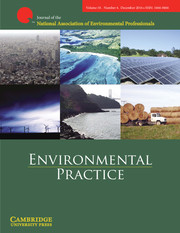Crossref Citations
This article has been cited by the following publications. This list is generated based on data provided by
Crossref.
Schwarz, Peter M.
Depken, Craig A.
Hanning, Alex
and
Peterson, Kristen
2009.
Comparing contaminated property redevelopment for mandatory and Voluntary Cleanup Programs in California.
Journal of Environmental Management,
Vol. 90,
Issue. 12,
p.
3730.
Cheng, Fangfang
Geertman, Stan
Kuffer, Monika
and
Zhan, Qingming
2011.
An integrative methodology to improve brownfield redevelopment planning in Chinese cities: A case study of Futian, Shenzhen.
Computers, Environment and Urban Systems,
Vol. 35,
Issue. 5,
p.
388.
Elliott, James R.
and
Frickel, Scott
2011.
Environmental Dimensions of Urban Change: Uncovering Relict Industrial Waste Sites and Subsequent Land Use Conversions in Portland and New Orleans.
Journal of Urban Affairs,
Vol. 33,
Issue. 1,
p.
61.
Elliott, James R.
and
Frickel, Scott
2013.
The Historical Nature of Cities.
American Sociological Review,
Vol. 78,
Issue. 4,
p.
521.
Glumac, Brano
Han, Qi
and
Schaefer, Wim F.
2015.
Actors’ Preferences in the Redevelopment of Brownfield: Latent Class Model.
Journal of Urban Planning and Development,
Vol. 141,
Issue. 2,
Glumac, B
Han, Q
and
Schaefer, W
2018.
A negotiation decision model for public–private partnerships in brownfield redevelopment.
Environment and Planning B: Urban Analytics and City Science,
Vol. 45,
Issue. 1,
p.
145.
Ali, Ahmed S.
and
Fayoumi, Mohamed
2018.
Framework for Brownfield Redevelopment Reuse, the Case Study of Ramses Zone, Cairo, Egypt.
SSRN Electronic Journal ,
Lojaničić, Damjana
2018.
Identification and classification of brownfield locations in Danube region in Serbia.
Arhitektura i urbanizam,
p.
46.
Liu, Yilun
Zhu, A-Xing
Wang, Jingli
Li, Wenkai
Hu, Guohua
and
Hu, Yueming
2019.
Land-use decision support in brownfield redevelopment for urban renewal based on crowdsourced data and a presence-and-background learning (PBL) method.
Land Use Policy,
Vol. 88,
Issue. ,
p.
104188.
Tharp, Kelsey
and
Guehlstorf, Nicholas Peter
2019.
Brownfields in Purple States: An Analysis of the Equity of Redevelopment Outcomes Under the Brownfield Program and Voluntary Cleanup Programs in Colorado and Ohio.
Public Works Management & Policy,
Vol. 24,
Issue. 2,
p.
160.
Glumac, B.
and
Decoville, A.
2020.
Brownfield Redevelopment Challenges: A Luxembourg Example.
Journal of Urban Planning and Development,
Vol. 146,
Issue. 2,
Chowdhury, Shaswati
Kain, Jaan-Henrik
Adelfio, Marco
Volchko, Yevheniya
and
Norrman, Jenny
2020.
Greening the Browns: A Bio-Based Land Use Framework for Analysing the Potential of Urban Brownfields in an Urban Circular Economy.
Sustainability,
Vol. 12,
Issue. 15,
p.
6278.
Foley, Theresa
Wolf, Ann Marie
Jackson, Chloe
and
Stephenson, Ryan
2021.
Development of a brownfield inventory for prioritizing funding outreach in Tucson, Arizona.
Geo-spatial Information Science,
Vol. 24,
Issue. 4,
p.
742.
Li, Xuqing
Wu, Hao
and
Hou, Huiying
2021.
Proceedings of the 25th International Symposium on Advancement of Construction Management and Real Estate.
p.
833.
Song, Yang
Lyu, Yang
Qian, Sitong
Zhang, Xinjia
Lin, Huiying
and
Wang, Shijun
2022.
Identifying urban candidate brownfield sites using multi-source data: The case of Changchun City, China.
Land Use Policy,
Vol. 117,
Issue. ,
p.
106084.
Turečková, Kamila
Martinát, Stanislav
Nevima, Jan
and
Varadzin, František
2022.
The Impact of Brownfields on Residential Property Values in Post-Industrial Communities: A Study from the Eastern Part of the Czech Republic.
Land,
Vol. 11,
Issue. 6,
p.
804.
Zhang, Xinjia
Song, Yang
Qian, Sitong
Wang, Shijun
and
Wu, Donghang
2022.
Exploring Spatial Distributions and Formation Factors of Brownfields in China: From Macro-Scales.
Frontiers in Environmental Science,
Vol. 10,
Issue. ,
Elliott, James R.
and
Smiley, Kevin T.
2022.
International Handbook of Population and Environment.
Vol. 10,
Issue. ,
p.
485.
He, Jialyu
Zhang, Jinbao
Yao, Yao
and
Li, Xia
2023.
Extracting human perceptions from street view images for better assessing urban renewal potential.
Cities,
Vol. 134,
Issue. ,
p.
104189.
Lin, Chuan
Huang, Yongfang
Liu, Yilun
Li, Guang
Zhou, Zegen
Zhong, Yuanjun
Wang, Hongmei
and
Li, Jinggang
2025.
Identifying underutilized land by eXplainable artificial intelligence and geographic similarity ensemble model with limited samples.
Habitat International,
Vol. 163,
Issue. ,
p.
103503.

